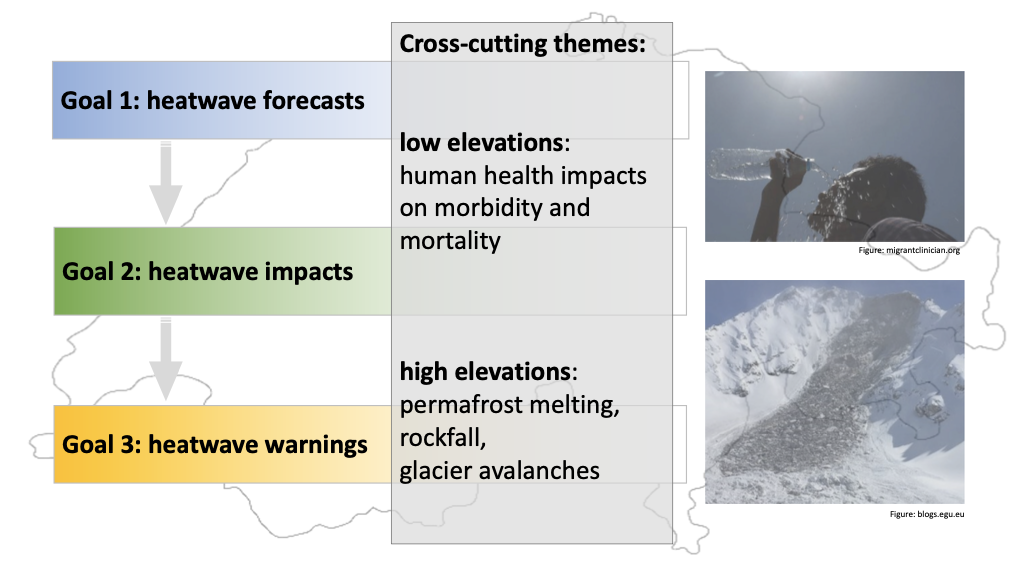Extended-range warnings for heatwaves in Switzerland (CROSS grant “HEATaware”) (2023 – 2025)
Heatwaves in Switzerland have various impacts on human health and ecosystems. Moreover, heat extremes might act as final triggers for high-Alpine hazards such as glacier break-offs and rockfalls, because they can accelerate the slowly growing disturbance of the Alpine permafrost layer due to climate warming. Heatwaves often occur concurrently with drought, which can impact agriculture, reduce lake and river shipping due to low water levels, and reduce nuclear power generation due to shortage of cooling water. As heatwaves have become and are expected to become even more common with climate change, it is crucial to predict their occurrence ahead of time and to issue warnings for stakeholders and the general public.

The goal of our transdisciplinary project HEATaware is, therefore, to assess the potential of heatwave prediction and warnings for Switzerland on timescales up to several weeks. To achieve this ambitious goal, HEATaware connects several disciplines and institutions, including collaborators from 1ETH, 2Université de Lausanne, 3EPFL, 4SLF, 5University of Bern, 6MeteoSwiss, and 7C2SM. The collaborators of the project include Daniela Domeisen1,2 and Michael Lehning3,4 as the Co-PI’s, Maria Pyrina1,2 and Dominik Büeler1,7 as the postdoctoral scientists primarily working on the project. Valérie Chavez2, Adel Imamovic6, Lionel Moret6, Sidhart Sivaraj5, Christoph Spirig6, and Ana Maria Vicedo Cabrera5 are further collaborators.
HEATaware consists of two parallel branches: on the one hand, we explore if the skill horizon for heatwave predictions in Switzerland can be extended with different physical-statistical pre- and post-processing methods. On the other hand, we evaluate the potential benefits of early warning products for sectors that are directly linked to human lives and livelihoods. One focus is on predicting heat-related mortality by coupling a statistical temperature-mortality model to extended-range temperature forecasts. Another focus is on better understanding and predicting the penetration of heatwaves into Alpine glaciers, rocks, and sediments, which might ultimately support early-warning systems for heat-related high-Alpine hazards.
The first results of HEATaware were presented at the Sub-Seasonal to Seasonal Prediction Summit at University of Reading, UK, in July 2023. In a case study for the Canton of Zurich during the hot summer 2022, we could show predictability of individual peaks of heat-related mortality up to 2 weeks ahead and indications of longer-lasting phases of excess mortality even up to 4 weeks ahead. On the other hand, we outlined our plans of using SNOWPACK, a model developed by SLF and primarily used for operational avalanche forecasting, to study how atmospheric heatwaves penetrate Alpine rock and influence permafrost.